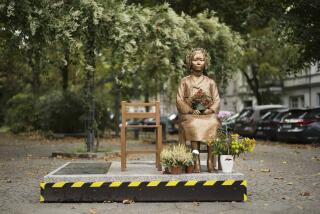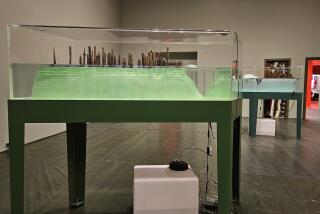A Statue of Limitations : Art: An American dealer is trying to find homes for two bronze Lenins cast in St. Petersburg, but so far there are no takers.
- Share via
NEW YORK — Over the last two years, as Communist regimes in the former Soviet Union and Eastern Europe were brought down, so were the huge statues of Lenin that were everywhere on those landscapes. So many of the monuments were either decapitated or destroyed that even Russian artists who had suffered under communism’s rigid aesthetic guidelines called for a halt to the spontaneous idol-smashing.
An American art dealer, responding to the spirit of that appeal, last fall brought the last publicly commissioned Lenin monument in the former Soviet Union to New York.
Now, as the 15-foot-high bronze Bolshevik gathers dust in a Manhattan warehouse, a second Lenin statue of similar proportions, also bought by the dealer, has cleared Customs in Brooklyn harbor and is lying alongside it.
“It’s a lot of bronze,” says New York art dealer Paul Judelson, who conceived of bringing the statues of the Bolshevik leader to the West and is now looking for permanent homes for them. Judelson was an early American supporter of the satirical conceptual work of young artists from Leningrad (now St. Petersburg). One of them, 25-year-old Sergei Bugaeev, a St. Petersburg native who calls himself Afrika, was the subject of a recent show at USC’s Fisher Gallery.
The huge Lenin statues are also St. Petersburg products. They were manufactured in the state Plant of Art Castings, located on the outskirts of the city, not far from the grave of Lenin’s mother. In a chance encounter with the plant’s director at the time of last August’s coup, Judelson and Afrika learned that the foundry was holding two Lenin figures, one ordered and paid for by the northern Caucasus city of Krasnodar, the other commissioned by the rulers of the then semi-autonomous republic of Bashkiria. (The first statue depicts Lenin in long coat and peasant cap; the second shows a hatless Lenin with a fist clenched defiantly across his chest.)
Judelson was told Krasnodar didn’t want another Lenin and the two sculptors who made the unsigned pieces would not even acknowledge them as their creations, thinking that artists, as well as works of art, might face the rage of the populace.
Judelson decided to take the pair, he says, to save examples of the Socialist Realist style from obliteration and preserve documents of Soviet history. (He won’t say how much he paid.) Judelson also thought a 15-foot Soviet leader’s likeness couldn’t hurt the Afrika retrospective that is still touring in the United States. So far, there are no plans for including a statue in the three remaining exhibitions.
When the first statue arrived unexpectedly in Montreal last November and headed down to New York on the back of a flatbed truck, Judelson saw how hard it would be to find a site for such a large object.
Just at that point, the Queens Museum, which will host an Afrika show starting April 23, announced it lacked the manpower to take the statue off the truck or to provide the 24-hour security Judelson wanted to ward off potential vandals in this country.
“It could be ideologically motivated or it could simply be someone who wants to spray-paint a statue,” Judelson said. “There are a lot of Russian expatriates here. Obviously, they would not be comfortable with the image of Lenin. I don’t blame them. You’d have to have one security guard around it, around the clock.”
It took 15 men two hours to haul the first statue in its crate of rough-hewn logs into the Manhattan warehouse, where it now lies alongside works by Jeff Koons, Donald Judd and Jim Dine. “I thought we were carrying stones for the pyramids,” Judelson remembers.
Soon after that statue was unloaded, Judelson contacted Selma Holo of USC’s Fisher Gallery about placing it at the entry to the Afrika show there. Holo thought the monument would have been a fitting complement to the exhibition, especially if the Lenin bronze were simply laid out horizontally in its packing crate. But when it came to bearing the shipping costs and the security Judelson stipulated, Lenin’s proposed trip to Los Angeles was called off. “We just didn’t have the money,” Holo says.
Los Angeles still remains high on the list for a final resting (or standing) place for the monument. The statue doesn’t need a mild climate to survive the next few hundred years, he says, “but Los Angeles, with the palm trees and the Pacific, would be a new setting for a Lenin statue.”
Another potential site for one of the monumental works is Bryant Park, once a drug- and crime-infested city park. Located behind the main New York City Public Library, the park has undergone a multimillion-dollar refurbishing under the guidance of a public-spirited citizens group that also provides round-the-clock security to maintain its serenity.
While Judelson negotiates with Bryant Park officials, he also is looking at other possibilities. He says he has received dozens of offers to take a Lenin bronze off his hands--but none involving a sum high enough to meet the costs he’s incurred buying, transporting and storing them, nor has any come from a place that would give either bronze the extensive exposure Judelson believes they deserve. One offer, he says, came from a theme park in Dogpatch, Ark., devoted to cast-off metal monuments.
Part of finding a place for the statues will inevitably involve determining why an institution would want to show one.
“It isn’t a great work of art,” admits New York art historian Marie Turbow Lampard, a specialist in the history of Soviet monuments, who examined the statue originally intended for Krasnodar, “but it is important to the art world, because it tells us what kind of art was done under the particular constraints of the Soviet period.”
For Afrika, the St. Petersburg artist, keeping each statue intact means not trivializing the Soviet period it represents. “It was built on the blood of the Russian people. This way it won’t be cut up, chopped up for souvenirs--little toys and bronze medals,” he says.
On the lighter side, however, Afrika conceded that the statues share some unintentional parallels with Pop art: “Pop art is the ideology of products; Socialist Realism is the product of ideology.”
These days, the foundry outside Leningrad where the statues were made is searching for new customers. Its last Socialist Realist work was a marble bust of Deng Xiaoping, ordered by the Chinese government. “Now,” Judelson says, “they’ve started casting church bells.”
More to Read
Sign up for Essential California
The most important California stories and recommendations in your inbox every morning.
You may occasionally receive promotional content from the Los Angeles Times.










